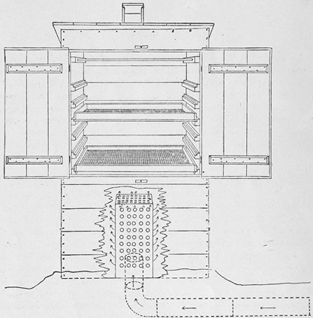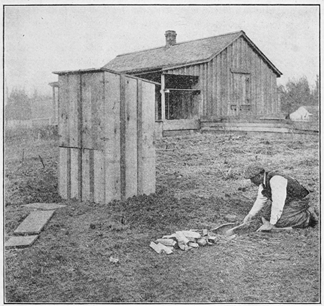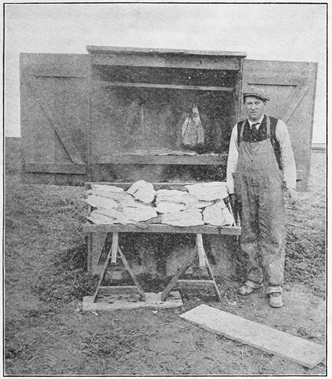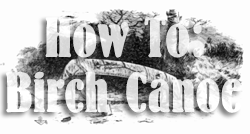A Practical Small Smokehouse
For Fish
Taken From: Economic Circular No. 27
A Practical Small Smokehouse For Fish
How to Construct and Operate It.
Issued By: Department Of Commerce - Bureau Of Fisheries
Introduction
In nearly every locality there are fishes of good food quality that seem to find no place in the ordinary domestic economy merely because they have not the most approved flavor or texture when prepared in the usual manner or because the bones are found troublesome. Among these are the bowfins, mooneyes, buffalofishes, carps, and sturgeons. Yet these fishes, when cured by the simple process of smoking, are of excellent flavor and may be kept several weeks if protected from mold. As a result of smoking, the flesh acquires a firm texture that makes the removal of bones much easier than in the case of fried, baked, or boiled fish.
Many fishermen find it difficult to dispose of their catch of the larger or "coarser" fish except at the very lowest prices, but if the fish are properly smoked, which requires very little labor or expense, a much higher price may be commanded. It is an additional advantage that the cured fish do not have to be dumped upon the market immediately, but the sales can be distributed over a period of several days, if necessary. Furthermore, the customer who would buy only 2 or 3 pounds of fresh fish for the day's use can properly purchase a supply of smoked fish to last one or two weeks. The smokehouse also solves a problem for the owner of a fish pond or lake who wishes to capture from time to time quantities of the "waste" fish, as he may deem them, that seem to crowd the game fish from his pond.
A small and easily operated smokehouse for fish is, therefore, a convenient apparatus and a profitable investment for the fisherman and for the pond owner. It will also serve a useful purpose to others. The cheaper fish are often sold at the river for nominal prices, from 1 to 3 cents a pound, while meats of equal food value cost several times as much. The householder would then be wise to purchase a quantity of the fish, smoke them in his own back yard, and stock the pantry with nutritious and palatable food, while effecting a real measure of economy. Here is evidently a good opportunity for co-operation between neighbors.
Most persons like smoked fish. Others will find it an easy taste to acquire. A word of caution should be offered. Do not judge smoked fish by the hastily, carelessly prepared product that some fishermen are willing to sell. A couple of hours' hard smoking may make a "smoked fish" in appearance but not in fact. Again, fish are smoked with excessive and long-continued heat until the product is dry and unattractive, and edible only when cooked. The smoking operation is simple, but it requires thought, care, and observation to get the most desirable results. Try smoking your own fish if the opportunity occurs; it is an interesting experience.

Fig. 1. - Plan of smokehouse. Note the iron rod (one of a series) near the top, sliding trays, smoke-spreader, and ventilator on top.
The construction and operation of a small and inexpensive smoke-house, which has been found to be entirely satisfactory when used experimentally on the Mississippi River by the Bureau of Fisheries, is described in the pages following. The methods of smoking, as given, refer to common fishes of the Mississippi Basin. With slight modification they may be applied to other species of the Atlantic or Pacific slopes, and doubtless to many marine fishes.
Construction Of The Smokehouse.
The house is 3 by 3½ feet inside measurements, 6½ feet high at the front and 6 feet high at the back, the roof having single pitch. If plain boards are used in constructing the house, the cracks must be covered with batten strips to prevent the escape of smoke. If yellow pine shiplap is available, a tight house is made without the necessity for battens. The shell of the house is made by nailing the boards horizontally to 2 by 4 inch corner pieces, which can be on the outside, if desired, so as to leave smooth inside walls.

Fig. 2. - A smokehouse hastily constructed in the field. The operator is kindling a fire in the fire box, which, it should be noted, is several feet removed from the house but connected with it by an underground flue.
The upper half of the front of the house is provided with two doors hung on the corner pieces, the outer edge of the right-hand door being fitted with a batten that overlaps the other door, thus serving to hold it shut and also serving in some measure to prevent the escape of smoke. The doors are held shut by two wooden thumb buttons, one fastened above and one below the right or battened door near the junction of the two doors.
An opening 4 inches square is left in the forward center of the roof, and over it is placed a boxlike ventilator having a 3 by 4 inch opening, front and back, for the escape of the smoke and moisture. This opening is fitted with a slide damper to control the escape of the smoke and also to assist in regulating the draft of the fire. The inside of the house is fitted with several removable wire trays of simple construction and a single horizontal series of rods of wood or iron extending across the house from side to side. The ends of the rods rest in or upon 2 by 2 inch strips nailed to the side of the house near the top. The trays slide upon rabbeted cleats, or plain strips, nailed to the side of the house and from 4 to 6 inches apart. These strips need not be level but should preferably have a slope of 6 inches toward the front of the house, thus permitting the fish on the trays to drain during the process of smoking.
The fire box and flue are of the sunken type. Into a trench 8 inches wide, 8 inches deep, and 7 feet long there are placed three sections of ordinary stove-pipe fitted at one end with an elbow. A common stove-pipe damper is placed in the middle joint of pipe, the ordinary handle being fitted with an extension by means of which the damper is operated from above when the pipe is covered with earth. This damper is the principal fire and smoke control. With proper regulation the fire can be left burning for a considerable length of time without attention. The pipe is barely covered with earth so that the elbow, which is to project upward into the house, extends a couple of inches above the surface of the ground. At the other end of the pipe a sunken fire box, 14 inches wide, 14 inches deep, and 24 inches long, is constructed of brick, a heavy piece of sheet metal covered with earth when in place serving as the top. A sloping trench in front of the fire box facilitates firing. After the fire box and flue are completed the house is set over the open end of the elbow, the latter being open and near the center of the house, and dirt is then banked around the bottom of the house to prevent outside drafts and escape of smoke.
A most important feature is the smoke spreader, a rectangular galvanized iron box 1 foot square and 2 feet long with numerous three-quarter-inch holes punched in the sides and ends to permit the escape of smoke. With the box placed over the mouth of the elbow considerable heat can be applied without scorching the fish and the smoke is very evenly distributed throughout the house.
Cleaning And Salting The Fish.
In preparation for smoking the fish is first split along the belly from head to vent and the entrails removed. With some species, such as the bowfin, a short longitudinal cut just behind the vent is made, disclosing a dark mass (the kidney), which should be removed. The head is then severed and the fish thoroughly washed. The scales should be left on. Those fishes having a dark abdominal lining should be scrubbed with a stiff brush until the lining is removed.

Fig. 3. - The smokehouse in operation. Some of the fish are on trays, one of which has been removed for the purpose of photographing. Others, in wire slings, are suspended from rods near the top of the house.
If the fish are small, no further treatment is necessary before placing them in the brine. If they are large, weighing 2 pounds or more, they should be split down the back from the inside, severing the ribs close to the backbone, the cut being sufficiently deep so that the fish will lie flat. Extra large fish may be cut into two or more lengths and the large body pieces split as just described. This method of preparing the large fish permits the salt to penetrate more easily and insures a more evenly smoked product.
The small sturgeon of the Mississippi River are only beheaded and eviscerated; sometimes a small portion of the tail is cut off to allow the fish to drain while smoking. Large catfish are skinned and cut into pieces weighing a pound or more. Large sturgeon should be treated in a similar way. Small catfish and bullheads are never skinned, as the skin aids in retaining the moisture and prevents the outer part from shriveling.
A brine is prepared by dissolving common barrel salt in clean fresh water until it will float a fresh egg, or 1 pound of salt is used for each gallon of water. The fish are placed in the brine skin side down and, as a general rule, should be left in the brine overnight. On removal from the brine they are given a light washing in fresh water and then placed on sloping trays or hung up to drain. Fish thus allowed to dry for a short time before being placed in the smoke-house cure better and present a better appearance when smoked.
Smoking The Product.
Fish which are too soft to hang by wires, such as carp, buffalo-fish, and bowfin, are placed on trays scale side down, while sturgeon, catfish, and bullheads are hung from the rods. If an entire lot is of the soft kind the house is filled with the trays, otherwise the upper trays are left out to make room for the fish that are to be swung from wires. Sometimes the soft fish are pressed between pieces of coarse wire cloth secured together in any convenient way. The use of "slings" prevents curling of the edges and permits the fish to be suspended from the rods instead of being laid on the trays.
A slow wood fire is started and the house filled with smoke. The heat should be gradually increased until the fish are partly cooked and then lessened somewhat, but the house should be kept full of dense smoke until the fish are properly cured. Bowfin should be smoked rather slowly, from 24 to 36 hours, depending on the size of the fish; carp and buffalofish usually require 18 to 24 hours; small sturgeon, small catfish, and bullheads need from 6 to 8 hours; large catfish and sturgeon, if cut into pieces, can be smoked in 10 to 12 hours. Some operators build the fire directly under the fish and smoke them in 3 or 4 hours, but such a short exposure does not allow the smoke to penetrate the thicker portions of the meat, and the novice who attempts it will spoil a great many fish by permitting the fire to get too hot. It is often necessary to tear off a small piece to test the fish while cooking.
After the fish are properly smoked they should be left in the smokehouse until cold. This eliminates the possibility of sweating, which is very likely to occur if the fish are taken out while warm. Sweating is one of the principal causes of the growth of mold.
Fuel Used In Smoking.
Green hickory is the best fuel obtainable for smoking all kinds of fish, and, when properly used, gives off a clear white smoke that colors the product a rich golden brown and imparts a flavor to the flesh that can not be produced by any other wood. As a fuel it is very easy to regulate and will give off heat and smoke for hours with one firing.
Dry oak is very good but produces a darker smoke which has a tendency to darken the flesh and imparts to it a mild acid flavor. Soft or hard maple is sometimes used, but as a general rule, it burns too freely, though the product smoked with such wood has a distinct, sweet flavor that is greatly esteemed by some. Green ash is as good as oak, but it gives off a lighter colored smoke and the flavor of the meat is very similar to that produced by hickory smoke. Green willow gives an abundance of smoke and for this purpose is excellent for use with other woods. Sawdust of all woods except the pine is very good for dampening the fire, but it does not burn freely enough alone to create the required amount of heat.
Corncobs when clean are equal to hickory. They give off a dense smoke, which unduly darkens the product, but on the other hand they impart a flavor that is very much liked by most people.
Pine wood imparts a resinous flavor to the product, making it almost unpalatable; a small amount may be used with other woods when better fuels are not available in sufficient quantity.
Protection From Mold.
Smoked fish are best kept in a fairly cool and dry place, to prevent molding. They should, of course, be protected from ordinary house-hold pests. Dipping in melted paraffin is a good means of providing a protective envelope about the fish. If this practice is followed, the fish should be handled as little as possible after clipping and allowing to cool, as the paraffin may crack and chip off. When the fish is to be prepared for the table, the paraffin is easily removed by immersing the fish for a few moments in hot water.




